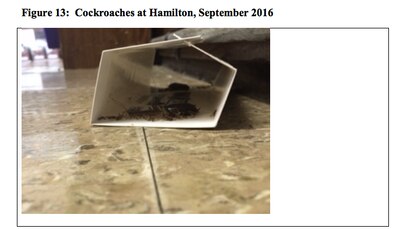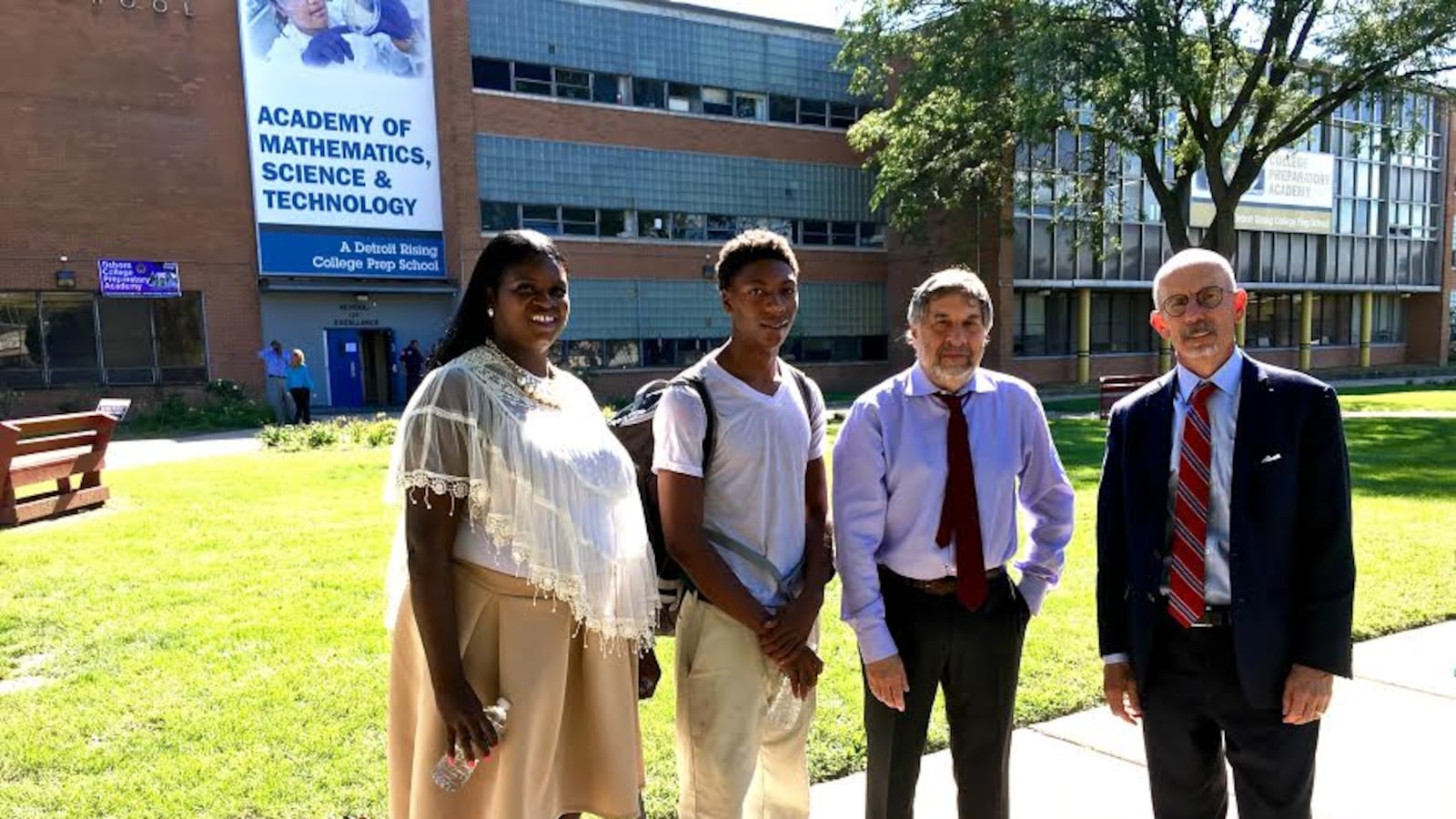The federal civil rights lawsuit filed this week on behalf of a Detroit school kids isn’t likely to bring a quick fix to Detroit’s troubled schools. Even successful lawsuits can take years to wend their way through the courts.
But as Detroit tries to turn things around with a new school district, the suit paints a bleak picture of what officials are up against.
The 136-page complaint reveals allegations of condoms strewn on playgrounds, bathrooms leaking sewage into hallways, and students left to grieve without support. The suit claims that these conditions make learning difficult in Detroit schools — a conclusion that a recent study bears out.
Relying on statements from students and teachers, the suit describes alarming conditions at five schools, including three in the main city district: Osborn Academy of Mathematics, Osborn Evergreen Academy of Design and Alternative Energy and the Medicine and Community Health Academy at Cody.
The suit also looks at two charter schools: Hamilton Academy, authorized by Detroit Public Schools, and Experiencia Preparatory Academy, which was authorized by Northern Michigan University until closing its doors in the face of financial problems last spring. It also mentions the Marion Law Academy, which is part of the state-run Education Achievement Authority.
Spokeswomen for the Detroit Public Schools Community District and the Education Achievement Authority did not immediately respond to requests for comment. Neither did officials from Northern Michigan University or CS Partners, the management company that ran Experiencia.
The full complaint is worth a read. It outlines all of the ways that these schools haven’t measured up on standardized tests and other objective measures and offers some disturbing descriptive details. These are just some of them:
Teachers are too few and not skilled
- At Hamilton … many students have a vocabulary of only a couple hundred words. Some students cannot even sound out letters.
- At Cody MCH, many of the students struggle when called upon to read aloud, with some stumbling over even monosyllabic words. Yet the few instructors originally designated as reading interventionists, already insufficient in number, must cover teacher vacancies in other classrooms.
- There is no meaningful training in literacy intervention available (at Cody MCH), even when requested by teachers … Plaintiff Jaime R. was in an English Language Arts course in ninth grade during which the class spent a large part of the year going paragraph by paragraph through a single novel, which has a third grade reading level.
- At Marion Law Academy, inexperienced teachers “used Google to search the Internet for lesson plans the night before class, and many paid out of their own pockets to obtain lesson plans on teacherspayteachers.com.”
- The middle school science classes at Hamilton are currently taught by a paraprofessional who states that she does not understand the material and cannot lead classroom experiments.
- In the 2015-16 school year, the seventh- and eighth-grade math teacher (at Hamilton) left several weeks after the start of school due to frustration with large class sizes and lack of support. He was temporarily replaced by a paraprofessional and then a special education teacher. Eventually, the highest performing eighth grade student was asked to take over teaching both seventh and eighth grade math, while the paraprofessional remained in the room to assist with classroom management. This student taught both math classes for a month.
English language learners are being left far behind
- There were no certificated EL teachers for long stretches of Experiencia’s three years of operation. In the upper grades, about 20 of the approximately 80 students were English learners, but the English language class available to them covered the same elementary phrases for two years, regardless of the skill level of the individual students.
- Plaintiff Esmeralda V.—who was more comfortable in Spanish than in English—was frequently called upon to assist her Spanish-speaking classmates by summarizing the material for them in Spanish. Some students relied on Google Translate in order to teach themselves English, although many EL students did not have access to the Internet outside of school.
- At Cody MCH, there are multiple students who do not speak or write fluently in English, yet there are no EL teachers at the school. When a family of Iraqi refugees sought to register their daughter at Cody MCH, their community school, DPS attempted to transfer the child to a school over 25 miles away because it could not support her EL needs. The teachers ultimately relied on other students who spoke Arabic to assist the EL students.
Classes can have 50 or more students
- Classrooms are stuffed with as many as fifty students and often do not have enough chairs and desks. Students sometimes sit on the floor, lean against walls, or congregate around teachers’ desks.
- One Osborn MST class had 42 students but only 32 desks. Another classroom had 52 students but only 37 chairs and fewer desks. The overcrowding also significantly exacerbated the extreme heat at many points during the year.
- Classrooms (at Law) become so crowded that a teacher who managed to obtain chairs for all 42 students had to pack them together so tightly that a left-handed student could not sit next to a right-handed student … When a teacher is absent and no short-term substitute is available, classes are frequently combined so one teacher may have up to 60 students in a single classroom.

Teachers are asked to buy their own supplies
- The teaching resources at Law are woefully deficient; textbooks, library books, and other curricular materials were thrown away into a dumpster at the beginning of the 2012-2013 school year when the school opened as an EAA school; the intent was to switch to digital learning. But the new digital platform was ineffective, lacked existing instructional materials, and was abandoned in the 2015-16 school year. Administrators told teachers at Law that they were expected to buy their own supplies.
- Textbooks at Experiencia were damaged and many years out of date, with taped spines and ripped and missing pages. The computers at the school were frequently broken, and when they did work, the Internet connectivity was so poor that they were nearly unusable. The third floor of the building technically had a library, but there was no librarian and students were not permitted to access the library or check out books without a teacher escort. Most of the time, the library remained locked.
Students and their families aren’t getting the help they need
- In those schools that do have access to a social worker, the social worker is often restricted to special education students, does not come every day, and is stretched beyond capacity, such that students wait months for an appointment.
- After a Hamilton student was kidnapped and murdered, his classmates were not provided any opportunity to grieve. No additional counselors were brought in, and the teachers were not offered any support or training on how to speak with the students about the tragedy. Instead, on the day the police found the boy’s body, the only school-wide reaction was an announcement by loudspeaker to remind the students, who were using their phones to share details about what happened and to communicate their grief, that cell phones were not allowed at school.
- At Experiencia, report cards were not translated into Spanish, and where teachers did not speak Spanish, no parent-teacher meetings with monolingual parents took place.
Students’ basic health and safety are imperiled
- At Hamilton, temperatures of over 100 degrees caused students and teachers to vomit and pass out during the first week of school.
- At Hamilton, the playground equipment—which is designed for 2-5 year olds, although the school serves children ages 5-14—is frequently broken. One of the playground slides is disconnected at the base so it shifts around, and the other has cracks with sharp pieces of plastic sticking out. Multiple students have sliced or otherwise injured themselves while playing.
- At Hamilton … it is not uncommon for meals to feature moldy bread and expired milk. The students know not to drink out of the water fountains, which are frequently infested with cockroaches and maggots, and the teachers and principal bring in bottled water they purchase themselves.

- At Law, several classrooms have flooded. In one fourth-grade classroom, a leaking hole in the ceiling created what students called “the lake,” and the teacher surrounded the area with yellow caution tape after multiple requests for repairs were ignored.
- At the Osborn schools, fire exits are frequently locked and chained to prevent unauthorized individuals from entering from the street. During the 2015-16 school year, a fire broke out in the school and students were given no notice to evacuate because the Osborn fire alarm system failed.
- Students (at Hamilton) also find bullets, used condoms, sex toys, and dead vermin on the playground, although teachers try to arrive early to clean the playground themselves.
- At Osborn MST, urine frequently leaks out of the men’s room and soaks the carpet in the hallway, causing the hallway to smell for days.

